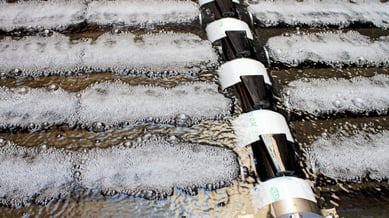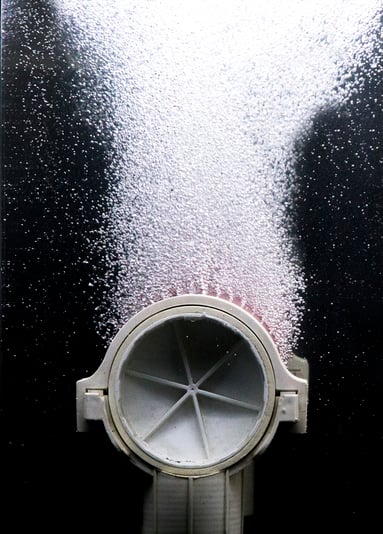EDI recognizes that panel diffusers have high efficiency. With this in mind we have created Mini-Panel devices as alternatives to the flat panel diffuser types to have with the oxygen transfer efficiencies of flat panel configuration while producing actual energy savings because of significant reductions in operating pressure requirements.

The operating pressure savings versus flat panels amounts to as much as 15 to 20% of the total operating pressure in the system.
MiniPanel Systems deliver lower total energy cost in most applications
EDI MiniPanel units are mounted on 4" and 8" pipe which help control the operating pressure in the system. Air pipe sizes are chosen to deliver minimum pressure loss for the operation of the system and are not fixed to a size limitation of the flat panel type of devices.No Flexing Required
With flat panels, routine flexing and increased flux rates rates are generated in order to try and prevent excess solids from accumulating and settling on the surface of the membrane.
By comparison, the EDI MiniPanel is mounted 0.2 to 0.5 meters above the floor. The MiniPanel has a curved surface that is easily capable of shedding solids and the MiniPanels have discrete spacing between the individual units in order to allow the solids to pass by the diffusers when air is turned off. This prevents the accumulation of heavy solids and/or operational issues of fouling and clogging of the MiniPanel; no flexing required. For mixing activities solids do not accumulate under or around or between the MiniPanel devices.
Heat resistance
Flat panel membranes are typically constructed as materials that offer specific warnings against use in high heat applications. This high heat can be from deep tank operation requiring cooling of the air ahead of the diffuser system or in hot process applications. Limitations of these devices are documented in the manufacturer’s literature and become a limiting factor in many applications; particularly because of the high stress effects on warm membrane materials.

Air flow ranges
The flat panel type devices are limited to low air flow rates in order to get proper distribution and utilization of the surface of the membrane.
By comparison the use of MiniPanel type devices can be controlled with individual orifices for total piping air distribution and the air distributed over the surface of the membrane with an engineered opening in the membrane itself.
Membranes
EDI membranes are designed to allow changing in less than two minutes per membrane.
Retrievable Option
EDI MiniPanel units are designed to allow easy application of retrievable diffuser systems. Retrievable diffuser systems can be advantageous in difficult applications and the MiniPanel is well suited to an engineered retrievable solution.
Using the EDI MiniPanel device allows access to the basin for cleaning and/or maintenance by walking between rows of diffuser units and working between those diffuser assemblies. By comparison a high floor coverage of flat panels prevents access for inspection, maintenance and/or any mechanical activity in the basin.
EDI MiniPanel units can be mounted on any type of a pipe, plastic or metal. These choices of materials are an engineering benefit for use by the engineer or owner.
By comparison, flat panel type of devices are limited to feeding with flexible hose connections in most applications or are limited to one type of piping for the installation.
For operation maintenance and overall system flexibility, the MiniPanel system offers high operating efficiency with low total cost of ownership (capital cost, energy cost, operation and maintenance costs as a net present value (NPV) or net present worth (NPW) evaluation).
At EDI Knowledge Center, you'll find invaluable resources and information from our engineers and industry leaders. The EDI Knowledge Center offers readers of our website a deeper exploration and understanding of the latest technologies, operator tips and developments in the wastewater industry. The Knowledge Center is available on the web and in your inbox.

Environmental Dynamics International
5601 Paris Road
Columbia, MO 65202![]() : +1.573.474.9456
: +1.573.474.9456
An Axius Water Company